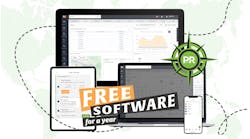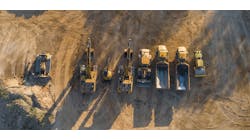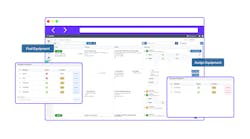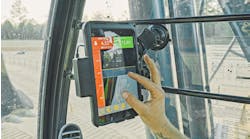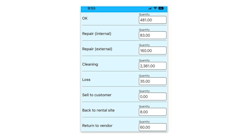RER’s October issue examined trends in software to enhance the service performance of rental companies. The expanded text of RER’s interview with Alert Computer System CEO Rob Ross is presented here.
RER: How does your software facilitate shop management?
Ross: Alert EasyPro's shop management capabilities are designed to scale up or down to fit the shop management needs of the rental center. For example, a smaller operation, perhaps without a dedicated service manager, is not interested in a lot of extra administration. So, we have built a basic service management system into every Alert system, allowing for basic tracking of parts, service work, and maintenance costs tracking for the rental fleet, or for charging customers for service work. It is streamlined and easy. For larger operations, or for companies with a fleet of larger machines, we have sub-systems that are much more detailed. For example, our Preventive Maintenance system provides detailed tracking of maintenance levels and intervals, down-line management, and other more advanced features.
A concrete example of down-line management: Alert lets you discriminate between "Hard Down" and "Soft Down" using color-coding in the equipment availability tracking screens. So this means, when a machine can be turned around quickly, because it is in for a routine PM, it is coded in green and the dispatcher has the ability to expedite it for rental if he really needs it. A "Hard Down" machine is coded red and can't be rented until all repairs are complete. The dispatcher or counter person can also drill down to see the work order, see what work has been completed or is yet to be accomplished, and more. This type of “360 degree” visibility will improve rental availability, not to mention reducing everybody’s blood pressure over communications between your rental staff, service staff and customers.
The Work Order system provides a more detailed method of tracking and scheduling shop labor, parts usage and ordering, through automated links to the optional Alert Purchase Order system, or using another accounting system. Some of our clients benefit from detailed integrations into ERP systems, like Microsoft Dynamics. We are a certified Microsoft Software Developer and can provide a high level of integration with Dynamics and other ERP and accounting system products.
How does your software facilitate the scheduling of maintenance according to manufacturer-recommended intervals? Can the software notify the rental company in some way when a machine is due for maintenance?
The Alert Preventive Maintenance system provides a detailed service interval tracking system for fixed assets, which can be set to manufacturer-specified terms. Recommended service intervals are tied to service levels, which have detailed PM forms to prompt and manage the manufacturer-recommended services that are to be performed at each service level. A piece of equipment might have more than one interval, for example, but the first one to become "due" triggers the maintenance due reminder. You can also build in a percentage tolerance, so that you don't send out a piece of equipment which will likely become due for maintenance on the next rental, within 10 percent more hours on the meter, for example.
Some of our clients even use the PM system to track customer equipment and charge fees for maintaining customer fleets on a PM schedule. The normal way the software notifies the rental company when a machine is due for maintenance is through the Maintenance Due report, but the Alert system also has some new tricks up its sleeves — such as a new interface with Qualcomm for equipment that is still in the field, and other types of "Alerts" triggered by a built-in reminder ("tickler") system for each piece of equipment. This way, you never forget license renewals and other date-sensitive requirements.
Does your software play a role in training of service technicians?
Our biggest training tool is the preventive maintenance system, since it offers the ability to completely document each type of service required for each machine, on the correct intervals. Our integration with RenTrain (www.rentrain.com) is a real plus, too, since it provides the industry's largest catalog of rental product information, specifications, and safety instructions. A service technician can click the RenTrain button in Alert EasyPro and have instant access to all kinds of useful information about a specific machine, including product pictures. This saves a lot of time and also can help provide quick information for customers.
Our Partsmart interface provides similar quick access by integrating with its large catalog of parts, organized by manufacturer. A technician can identify a part and then see an on-screen schematic drawing of how the part fits together within an assembly. Using a “lasso” tool with the mouse, the service technician can put the part on a pick list and find it in the right bin. If the item needs to be ordered (versus being in stock), it is color-coded in red directly on the schematic drawing. Parts that are already in stock come up in green.
We are always working on relationships with third-party partners, as warranted by demand from our customers. We have done extensive research on the SmartEquip system, for example, working closely with the vendor and our current customers. We have already designed an interface, and we hope to bring an integrated product to market with a strong ROI for our clients in the future.
What role does your software play in the organization of warranty information?
Alert has the ability to separate warranty work through the work order system, and to make claims and track their progress through its built-in accounts receivable system. A user can automatically convert reports to spreadsheets, or create custom reports for producing and filling out warranty claims forms, which vary by manufacturer. It is capable of maintaining a detailed (electronic) record of warranty terms and conditions, expiration dates, and correspondence with the manufacturer.
How does your software facilitate keeping track of service history on an individual machine?
Alert has a built-in "document imaging" system, which provides instant look-up for the complete work order and/or contract history of each machine. Reports summarize this information to make it meaningful across each class of equipment and across your entire fleet for return-on-investment purposes and for tracking your service department's efficiency.
Does your software facilitate parts organization and the buying or selling of parts online?
The Alert Advanced Parts and Sales system is a sub-system that provides detailed tracking of parts. It integrates with the Alert Purchase Order system, which can produce an on-line order, or it can be used with third-party purchase order modules as a part of an ERP or accounting system. A newly developed sub-system allows the import and export of parts catalogs on a user-definable basis, eliminating the need for custom reports or interfaces. A simple form is used to create a “mask” for the data to be imported or exported, including price changes, product descriptions, and more. Sales item lists can even be exported to an Excel spreadsheet, modified and improved using Excel, and returned to the system. Many of our clients are interested in using this feature to clean up old data that tends to clog up the system or impede searching capability. Clients who are new to the Alert system, coming off an older system, especially like this feature because it gives them a “clean start” to their sales and parts inventory. Combined with our Physical Inventory system, which offers cycle counting to get inventory quantities up-to-date, bar code support, and other new features, Alert can really help our clients get their parts business organized and profitable.
How does your software facilitate the organization of the shop in regard to prioritizing jobs or separating rental fleet repair from the repair of customer-owned equipment?
The Alert Work Order system tracks and separates internal repairs from customer repairs, tracks estimated completion dates, allows for instant status updates for handling customer inquiries, and provides a built-in ability to instantly fax or e-mail bids, completed work orders, and more. Reporting separates internal work orders and internal parts consumption from customer work orders and customer parts sales. Shop reports help in organizing and prioritizing repairs based on defined criteria. A built-in report writer also allows shop managers to design more specialized reports for establishing and tracking priorities and the flow of service work.
How does your software facilitate cost management and cost analysis, the management of cost and income in the shop itself? Can it help the user keep track of the profitability of a particular piece of equipment by helping shop managers analyze maintenance and service costs?
Some of our clients are setting up the shop as a completely separate business, to better analyze costs and profitability. In the case of multi-store rental businesses whose branches work together in a regional market, this also allows for centralization of many shop functions, for more efficient use of shop labor. Alert also offers detailed maintenance tracking for each piece of equipment by each location, to better compare the history in each branch location for shared equipment. ROI analysis per piece of equipment, net of maintenance and service costs, is provided in a variety of report formats. (This reporting is available regardless of whether the shop is handled as a separate business entity.)
Does your software help the field service technician? Can he access information using a wireless device, laptop or other means?
Since the Alert system is web-enabled, a field service technician with authorized security and Internet access can perform all the same functions in the field with a basic laptop as in the office.
Does your software provide the technician with a checklist of items to be performed at various intervals or items to check before a returned piece of equipment can go to the "ready" line?
Yes. Alert has up to 95 service level settings for each piece of equipment. For example, a setting to Level 95 produces a maintenance checklist each time a returned piece of equipment is returned to the ready line.
Does your software in some way track hours of a machine that's in the field and therefore aid in scheduling in-field maintenance?
Using our new Qualcomm interface, this automated data collection capability is now available. Without using Qualcomm's more advanced features, Alert maintains an automatic "average usage per day" field in its fixed asset recording system, so it estimates what hours are likely to have expired based on the prior contract history of the machine. Hours and other measurements may also be collected manually and entered into the system, even though the equipment is still in the field.
Do you find that your rental company customers are increasingly interested in using software to help organize their shop and service capability?
Yes. This is an especially popular "winter project" for our clients who are looking to achieve greater levels of efficiency and improved profits through better shop and service management. We provide low-cost classes at our User's Group meeting in November, which are always well attended. We also provide periodic "webinars" to train owners and shop managers on how to get their service businesses to the next step in profitability through better use of their software.
Does your system automatically update inventory availability after shop uses system to report on completion of service tasks?
Yes, because Alert updates equipment availability on a real-time basis, as soon as service work is completed in the shop, the counter immediately knows that the equipment is available for rent. On the other hand, the Alert system allows management to determine whether taking equipment "down for maintenance" (and out of availability) is an automatic function or requires a manager to decide.
How will this area (the facilitating of shop organization) evolve in the coming years, in your company's software and in the industry as a whole?
We have formed a popular session at our annual user's conference, called the "Heavy Equipment, Service, and Sales" Advisory Council, to set the direction of our future software development in these areas. Each year, this group comes up with viable improvements that will have short-term and long-term benefits for shop management. Working together with this group last year, we implemented 100 percent of agreed-upon recommendations in this year's latest software revision. We see this type of effort as essential in our effort to keep up with (and lead) the rental industry.

